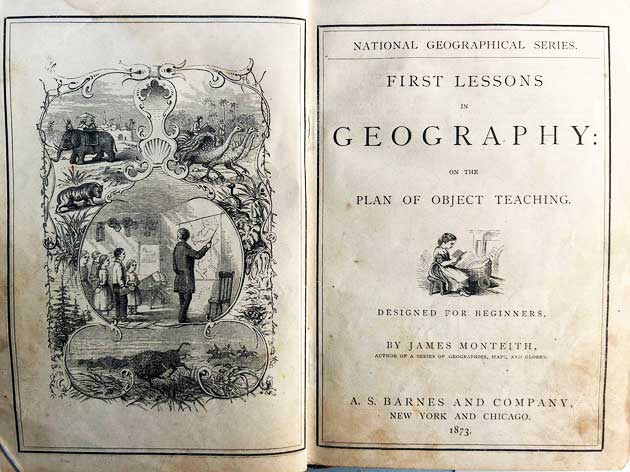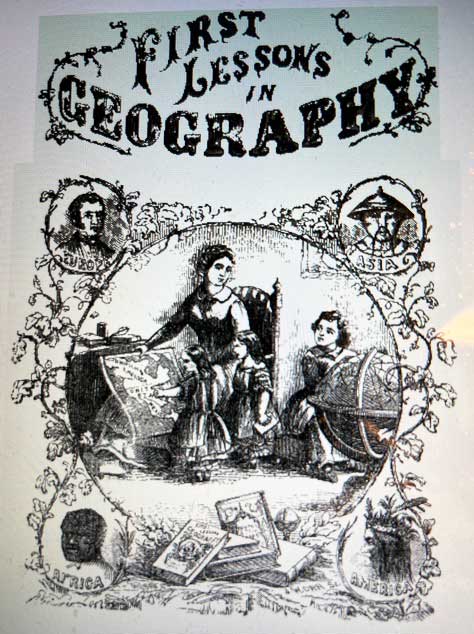March 2024
Vintage Discoveries
Old geography textbook taught my ancestor the ‘basics’
by Ken Weyand
A small and very old textbook turned up recently in the back of a bookcase. I thought it might have been something I had acquired from an antique shop, but it turned out to have been the property of my grandmother’s younger brother, William H. Van Horn, whose short life began in 1864 and ended in 1901. (My mother’s name also is in the 1873 book, indicating she probably read it when she was a child in the early 1900s.)
The cover (measuring 5 x 7 inches) is in such poor condition it’s virtually unreadable, and defies any attempt to photograph it. A single strip of clear tape around the spine shows someone tried at some point to keep the covers together, but their worn edges and faded surfaces proved beyond repair.
However, the 48 inside pages are well-preserved and show how many youngsters in the years following the Civil War were taught about their world. The inside cover announces the book’s title, “Monteith’s First Lessons in Geography,” published by A.S. Barnes and Co., New York and Chicago. Searching online, I discovered that an ebook version of my book exists, published by Project Gutenberg, a library of more than 70,000 freely readable ebook titles. Their cover illustration is similar to the actual book, and I’m reproducing it here, acknowledging their generosity.
James Monteith, author of my 1873 book, authored a “series of geographies, maps and globes,” according to the inside cover. Monteith’s book was “on the Plan of Object Teaching, Designed for Beginners.” In his Preface, Monteith declared the book was to present the subject in its simplest form. “It treats of GENERAL FEATURES, such as the locality and description of Continents, Countries, States, Rivers, Mountains (etc), without dwelling prematurely upon details which embarrass the learner in his first effort.”
Like many of his contemporaries, Monteith combined facts with religious zeal: the book’s first illustration shows a crude globe, with the headline, “In the Beginning God Created the Heaven and the Earth.” On a later page, under “Lesson LVIII,” Monteith presents an illustration of turbaned worshippers bowing down to a seated idol, with the words, “This is a picture of a HEATHEN TEMPLE or place of worship. It contains frightful looking objects, before which you see people falling on their knees and faces. Such people are called IDOLATERS, PAGANS, or HEATHENS.” Monteith continues to warn his readers, “You will be surprised to learn that there are millions of idolaters. They live in Asia, Africa, and Islands of the Pacific Ocean.” In a final paragraph, he reassures: “Missionaries have been sent from the United States and Europe to teach those ignorant people about the TRUE GOD who says in his commandments, “THOU SHALT HAVE NO OTHER GODS BUT ME.”

Title page from the book in ebook form, courtesy Project Gutenberg.

Cover of "First Lessons in Geography"
Montieth also teaches his young readers about the settlement of the U.S., with an illustration of “savage Indians” attacking a white family. After a paragraph describing the “great cruelties from the Indians,” he assured that “at present, there are no savages east of the Mississippi.”
He concluded: “The first inhabitants of a place are called settlers, or colonists.”
William Van Horn wrote to his sister (my grandmother) from Murdock, KS, west of Wichita, in 1886, that he was “working for a railroad man. He says if it stays dry so that he don’t want me on the farm he will give me a job on the railroad with a surveying company. That will be nicer than shoveling dirt, and better wages.”
William had been married twice. In 1892 he married Minta Apperson, and they had two sons, William and Earl, both born in Eureka, KS. Ancestry records show he married again in 1894 (wife unknown), and was living in Topeka as of the 1900 census. He died there in 1901.
Ken Weyand is the original owner/publisher of Discover Vintage America, founded in July 1973 under the name of Discover North.
Ken Weyand can be contacted at kweyand1@kc.rr.com Ken is self-publishing a series of non-fiction E-books. Go to www.smashwords.com and enter Ken Weyand in the search box.

